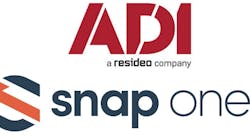A Highly Integrated Component
Q: What's the difference between Exit Devices and Request to Exit Bars?
A: Although these two types of hardware may be similar in outward appearance (and their usage), they are quite different.
Exit devices are the most highly integrated component used in security because they serve as a physical locking device, a life safety device, an electronic security device, and a door control device. Exit devices are available in two design styles: the traditional cross bar type and the contemporary touch bar. The various types of exit devices are:
- RIM-Surface applied to the door.
- MORTISE-Lock case installed (mortised) into the edge of the door.
- SURFACE VERTICAL ROD-Surface applied to the door. Top and bottom latching.
- CONCEALED VERTICAL ROD-All components are concealed within the door or installed (mortised) in the edge.
A Request to Exit bar is another type of device which resembles a panic bar and is used in electrically controlled doors as a Request to Exit control.
Exit devices and Request to Exit bars are intended to be able to be operated without prior knowledge or training. Only pressure needs to be applied to a horizontal bar or push pad mounted to the door. Such devices allow normal daily access through an opening while meeting numerous security and fire safety requirements. The type of door and the existing hardware, as well as the specific requirements of the application, will all need to be considered when specifying the equipment for your project.
Another type of door hardware, the Exit Lock, utilizes a paddle or other similar means of actuation. Exit Locks are usually deadbolt type devices and are not used on heavily trafficked doors.
System designers often gravitate towards Request to Exit bars because, in addition to providing a convenient means of egress, they are deemed to be easier to install than conventional exit hardware. Plus, ostensibly, they satisfy Building Code Requirements.
At one time, Fire Marshals didn't notice that the bars weren't positive latching locks, but rather, just a switch controlling a magnetic lock. Nowadays, however, these officials are on the look out for this type of violation. Why the frequent incorrect application of electromagnetic locks and Request to Exit bars? The main reason is ignorance. Some dealers are not aware that they're not meeting building code. Others simply may not know how to install exit devices.
There certainly is a time and place for electromagnetic locking devices and Request to Exit bars. No doubt, they are the ideal solution for a wide variety of applications. However, for many applications, bars are not acceptable. In these cases, electromagnetic locks and Request to Exit bars actually are more problematic and expensive to deploy than conventional exit hardware because of the additional system elements which must be included into the project to make them safe.
Exit devices are classified as either Accident Hazard Devices, or Fire Exit Hardware. Both are designed to provide unrestricted exit with a free path of egress. However, Fire Exit Hardware has additional design features to keep a fire door latched to prevent the spread of smoke and fire, thus maintaining the integrity of the fire assembly. More on this subject next month.
Security Dealer Technical Editor Tim O'Leary is a 30-year veteran of the security industry and a 10-year contributor to the magazine. O'Leary's background encompasses having been a security consultant since 1986 and an independent security company owner/operator, in addition to his research and evaluation of new technologies and products introduced to the physical and electronic security fields. He is a member of the VBFAA (Virginia Burglar and Fire Alarm Association); certified for Electronic Security Technician and Sales by the VADCJS (Virginia Department of Criminal Justice Services); and, has served as a judge for the SIA New Product Showcase. Send your integration questions to [email protected].

